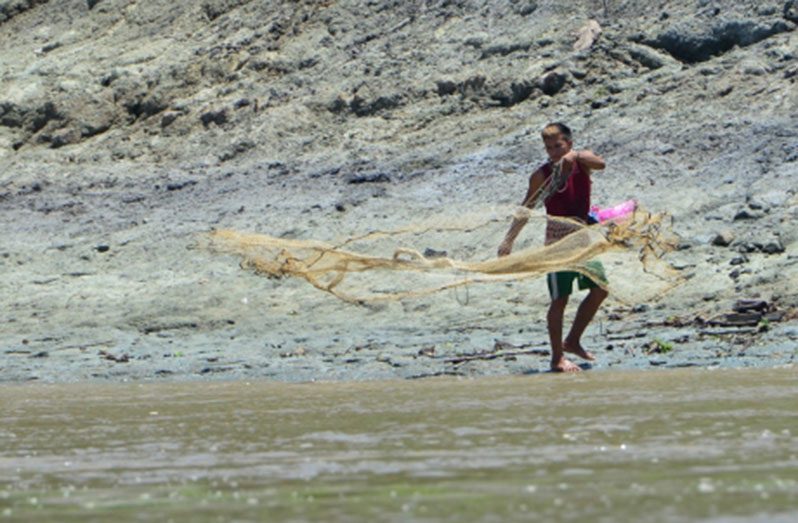THE running fresh water of the Amazon River is a welcoming sound to the peoples of the indigenous resguardo (reserve) in Puerto Nariño, southern Colombia. This watercourse is the only access to the banks of rivers, lakes, flood plains and mainland areas that connect the 22 communities where the Tikuna, Cocama and Yagua Peoples live.
To obtain food according to each season, the Tikuna, Cocama and Yagua Peoples combine different practices, such as fishing, hunting and chagras farming, an ancestral, diversified productive system in which annual and perennial species are cultivated, and where trees are selectively cut and burned to replicate healthy forest succession.
As if musical chords, these activities are all interconnected, each of them with its own time and space that respect the flooding cycles with their seasons of high and low waters. These seasons set the pace. Floods come first, replenishing the ecosystem of the plains. The fish reproduce, eat and fertilise the soil. Then comes fishing in low waters after the fish are abundant. Lastly, when water is scarcer, but the soil has been enriched in organic matter, farming and hunting are the main ways to produce food.
THE BEAT OF SHIFTING CULTIVATION
Food generation also has a rhythm. Like the Tikuna, Cocama and Yagua Peoples in the Amazon, the Khasi Peoples in the Indian Himalayas practise a cyclical, shifting cultivation system called Jhum, which also follows its own beat. Every year, old fields are left fallow for a period of seven to 10 years, while a new plot is cleared for farming. This field rotation helps to preserve the fertility of the soils. A traditional practice common to the Indigenous Peoples of Asia, Jhum fields are incredibly productive, and can generate over 60 different species of crops.
This people inhabit the Khasi Hills district in Meghalaya, India, a region that receives one of the greatest rainfalls in the world. A millennial matrilineal society, the Khasi have also adapted their territorial management practices to the seasons, and they generate nutritious food and livelihoods not only for the entire community, but with future generations in mind.
The Inári Sámi Peoples in the Arctic region of northern Finland also align themselves to nature’s cycles. This people of reindeer herders, fishers, hunters and gatherers move from the forests in the winter to the treeless areas in the summer, following in the footsteps of the reindeer, their primary source of food and livelihoods.
Following the natural cycles to generate and consume food is one of the characteristics that make Indigenous Peoples’ food systems some of the most sustainable in the world, acting in accordance with Mother Earth, and letting her dictate the rhythm. This respect for natural cycles is essential for conserving biodiversity, managing ecosystems, and ensuring diversified, nutritious and healthy diets.
TIME-TESTED
Indigenous Peoples’ food systems have survived for centuries, generating an incredible diversity of food, without depleting the natural resource-base of the ecosystems. Why? Because Indigenous Peoples understand that people are not separated from nature. Rather, they live in harmony with Mother Earth, where humans and non-humans are considered with an equal level of respect.
This respect for natural resources and biodiversity creates a resilience that is a key element of their food systems. Their solidarity and reciprocity mechanisms of food sharing, and the rich biodiversity found in their territories are important safety nets that safeguard crops, and a wild-food supply, particularly important during the lean season, or in periods of food scarcity.
Indigenous languages also play an essential role in the resilience of their food systems. About 4 000 of approximately 6, 700 languages currently spoken in the world are indigenous languages, which are rich in words related to food generation and traditional practices. For instance, the Baka Peoples in Cameroon are renowned for their names and knowledge of more than 500 plants for medicinal, material and spiritual purposes, while the Khasi Peoples in India have specific terms to determine the quality of the soil. When an indigenous language starts to deteriorate, so does the traditional knowledge of the community, resulting in community members forgetting the names of plants, herbs, and eventually their practices.
This wealth of knowledge, accumulated generation after generation, and a sharp understanding of the relationships between the elements in the ecosystem guarantee the protection of their food security, and the biodiversity in their ancestral territories.
Considered as some of the most sustainable and resilient on the planet, Indigenous Peoples’ food systems are about the future of food. They can play a significant role in transforming food systems, making them more sustainable and respectful of nature. For this reason, Indigenous Peoples raised their voices in the Pre-Summit of the United Nations Food Systems Summit, requesting that their food systems be considered as a game-changing solution.
Today, when the world looks to making our food systems more responsible and better suited to the future, Indigenous Peoples are ready to share their knowledge of sustainability and resilience, and their biggest secret: How to follow the rhythm of Mother Earth. (FAO)













